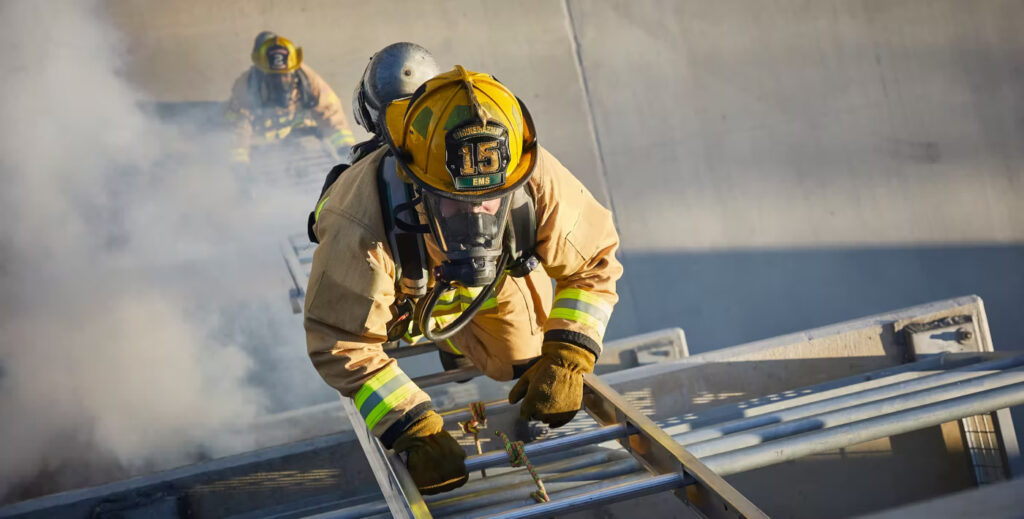
Introduction
When it comes to working with fire, whether as a firefighter, industrial worker, or in other specialized fields, safety is paramount. The intense heat, potential for burns, and exposure to hazardous fumes require a comprehensive set of Personal Protective Equipment (PPE). In this article, we’ll explore the essential PPE required for individuals working with fire to ensure their safety and well-being on the job.
- Fire-Resistant Clothing:- The foundation of PPE for working with fire is fire-resistant clothing. This includes fire- resistant coveralls or suits made from advanced materials like Nomex, Kevlar, or similar fire- retardant fabrics. These suits provide a barrier between the wearer’s skin and the flames, offering protection from radiant heat, direct flame contact, and hot particles. Fire-resistant clothing is designed to self-extinguish if ignited, minimizing the risk of severe burns.
- Fire-Resistant Gloves:- Hands are particularly vulnerable to burns when working with fire. Fire-resistant gloves, often constructed from similar materials as fire-resistant clothing, provide a crucial layer of protection for the hands and wrists. These gloves not only shield against heat and flames but also offer grip and dexterity, enabling workers to handle tools and equipment safely and efficiently.
- Fire-Resistant Footwear:- Feet are at risk of burns, punctures, and other injuries when working around fire. Fire- resistant footwear, often incorporating heat-resistant soles and built-in protection, ensures that the feet are shielded from heat and potential debris. These boots are also designed to be slip-resistant, providing stability on various surfaces while working in hazardous environments.
- Protective Eyewear and Face Shields:- Eye protection is vital when working with fire due to the potential for flying debris, hot embers, and intense light. Protective eyewear with impact-resistant lenses shields the eyes from these hazards. In situations where there is a risk of facial burns or splashes, a face shield can be worn in combination with the eyewear to provide comprehensive protection.
- Helmets and Headgear:- Head protection is essential in environments where falling debris, collapsing structures, or impact risks are present. Firefighting helmets, often made of heat-resistant materials, not only guard against head injuries but also incorporate features like face shields, neck protectors, and chin straps for added safety. These helmets are designed to withstand high temperatures and provide a secure fit for the wearer.
- Respiratory Protection:- Smoke, toxic gases, and particulates are significant hazards when working with fire. Respiratory protection, such as self-contained breathing apparatus (SCBA) or air-purifying respirators, ensures that workers have access to clean and breathable air. SCBA units are especially crucial for firefighters, allowing them to work in smoke-filled environments while maintaining respiratory safety.
- Communication Gear:- Effective communication is essential for coordination and safety during fire-related operations. Communication systems like two-way radios integrated into the PPE enable workers to stay connected with their team members and relay crucial information even in noisy or chaotic environments.
- High-Visibility Elements:- In situations involving firefighting or emergency response, high-visibility elements are vital to ensure that workers are easily identifiable to their colleagues and to maintain coordination. Reflective strips, patches, and clothing ensure that workers can be seen even in low-light conditions, reducing the risk of accidents and improving overall safety.
Conclusion
Working with fire demands a comprehensive set of Personal Protective Equipment to safeguard individuals from the various hazards posed by flames, heat, debris, and toxic fumes. Each piece of PPE serves a crucial role in creating a multi-layered barrier between the worker and the potentially life-threatening elements. Fire-resistant clothing, gloves, footwear, eyewear, helmets, respiratory protection, communication gear, and high-visibility elements collectively form the arsenal that protects those who take on the challenging task of working with fire.
While these PPE components provide a significant level of protection, it’s also essential for individuals to receive proper training in their use, maintenance, and limitations. With the right PPE and a commitment to safety protocols, workers can perform their duties with confidence, knowing that they are equipped to face the dangers of fire head-on while minimizing risks to their health and well-being.

